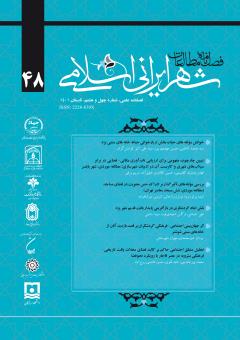تحلیل منطق اجتماعی حاکم بر کالبد فضای محلات بافت تاریخی- فرهنگی بشرویه در عصر قاجار با رویکرد نحوفضا
محورهای موضوعی : مطالعات محله در شهرهای ایرانی اسلامیسعیده پورعابدینی 1 , عابد تقوی 2 , حسن هاشمی زرج اباد 3
1 - دانشآموخته کارشناسی ارشد باستانشناسی، دانشگاه مازندران، بابلسر، ایران
2 - استادیار گروه باستانشناسی، دانشگاه مازندران، بابلسر، ایران
3 - دانشیار گروه باستانشناسی، دانشگاه مازندران، بابلسر، ایران
کلید واژه: ساختار کالبدی- عملکردی, تئوری چیدمان فضا, یوسیالدپزمپ, شهر بشرویه, دوره قاجار,
چکیده مقاله :
آنچه شهرها را ترجمه میکند، نحوه آراستگی محلات در کنار یکدیگر است که این انتظام مستلزم چگونگی چینش کاربریهای مختلف، توزیع مناسب و سازگار تسهیلات شهری در کنار یکدیگر و نیز شبکة راهها در سطح محلات است. همجواری مطلوب زیرساختهای عمومی شهری در سطح محلات منتج به ممانعت از ایجاد نابرابریهای اجتماعی و بهتبع آن نابرابری فضایی و جداییگزینی فضایی در ساحت محلات شده است که این همسویی بر روی عملکرد فرم، پیکرهبندی فضایی و حیات شهرها در بستر زمان و مکان اثرگذار بوده است. هدف از این جستار، خوانش رفتار فضایی بینامتنی بین انسان و محیط در بافت تاریخی شهر بشرویه در دوره قاجار است که زمینهساز بروز سازمان فضایی و منطق اجتماعی فضا و همبستگی در ساختار کالبدی-عملکردی محلات این شهر شده است. پژوهش حاضر ازنظر هدف در زمره تحقیقات کاربردی است و از نظر ماهیت و روش توصیفی-تحلیلی است. اطلاعات نظری پژوهش از شیوه مطالعات کتابخانهای و بهرهگیری از یافتهها، اسناد و مدارک میراثفرهنگی شهر بشرویه جمعآوری گردیده است و به جهت خوانش منطق اجتماعی فضا که حاکم بر کالبد فضایی محلات شهر بشرویه از دو رهنمون کمی (روابط، شاخصهای نحوفضا) و کیفی (انگاره نحوفضا) موجود در تئوری چیدمان فضا، استفادهشده است. بر مبنای هدف یاد شده، پرسش اصلی پژوهش عبارت است از: بر اساس تئوری نحو فضا نقش عوامل کالبدی-عملکردی در شکلدهی و توسعه منطق اجتماعی فضا شهر بشرویه در عصر قاجار چگونه بوده است؟ نتایج پژوهش نشان میدهد: عناصر سازندةساختار کالبدی محلات بشرویه در عصر قاجار در راستای رفع نیازهای ساکنین محلهها و بهمنظور حفظ و تقویت هویت فرهنگی- اجتماعی آنها شکلگرفتهاند که در این میان گذرها نقش راهبردی در پیدایش رفتارهای جمعی (ناشی از فعالیتهای انسانی) در میانمحلهها و نیزایجاد همبستگی میان عناصر کالبدی محلات را برعهده داشتهاند. دستاورد این نظم فضایی،وجود یکپارچگی فضایی در کل و عملکرد آن در خردشده است.
What is translation of cities is the way that this discipline entails the arrangement of different land uses suitable and compatible distribution of urban facilities beside each other as well as the roads network at the localities level. The desired neighboring of infrastructure and urban facilities on the localities has resulted in preventing the establishment of social inequalities and consequently spatial inequality and spatial inequality in the areas that have influence on the function of spatial and spatial configuration of cities in the context of time and space. The aim of this research is to read the Integration spatial behavior between man and the environment in the historical context of the city of Beshravieh in the Qajar period, which has become the basis for the emergence of spatial organization and social logic of space and correlation in the physical-functional structure of the neighborhoods of this city.The current research is applied research in terms of its purpose and descriptive-analytical in terms of its nature and method. The theoretical information of the research has been collected from the method of library studies and using the findings, documents and documents of the cultural heritage of Beshravieh city. And in order to read the social logic of the space governing the spatial body of the neighborhoods of Beshravieh city, two quantitative guidelines (relationships, indicators of space syntax) and qualitative (idea of space syntax) existing in the theory of space arrangement have been used.According to the theory of space syntax, what was the role of physical-functional factors in shaping and developing the social logic of the space of Beshravieh city in the Qajar era? The results of the research show: the building elements of the physical structure of the neighborhoods of Beshravieh in the Qajar era were formed in order to meet the needs of the residents of the neighborhoods and in order to preserve and strengthen its cultural-social identity. And they have also been responsible for creating correlation between the physical elements of the neighborhoods. The achievement of this spatial order is the existence of spatial unity in the whole and its function in the minuscule.
